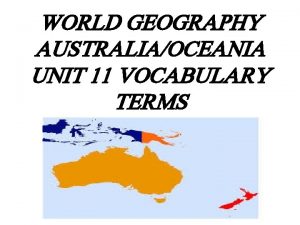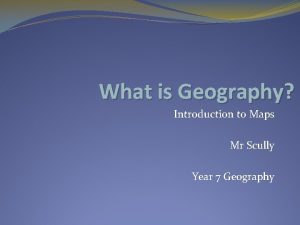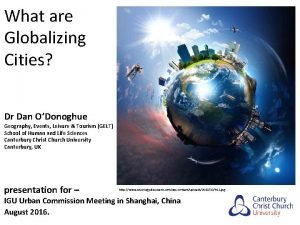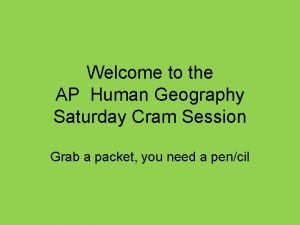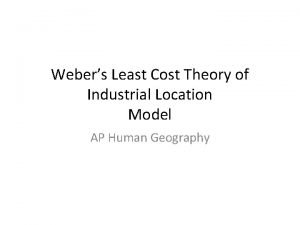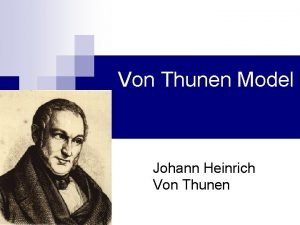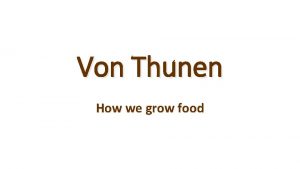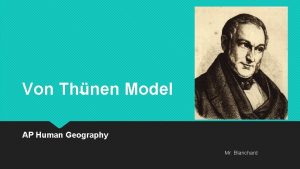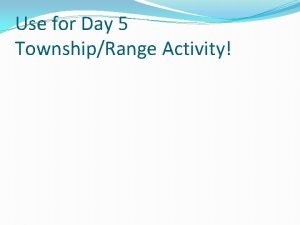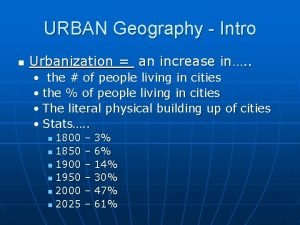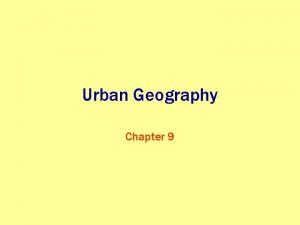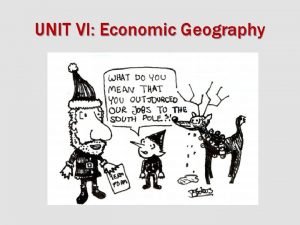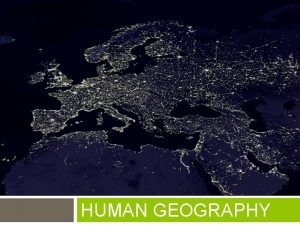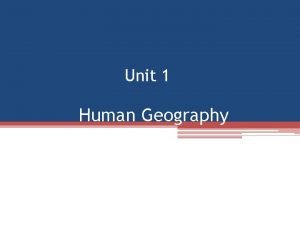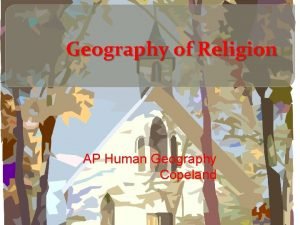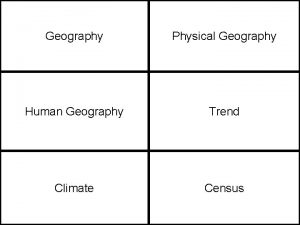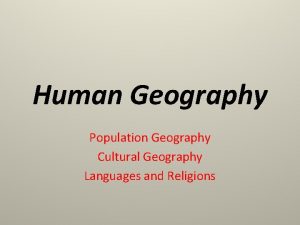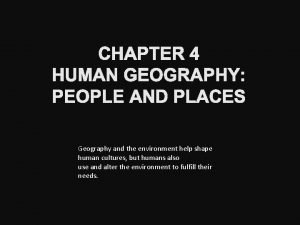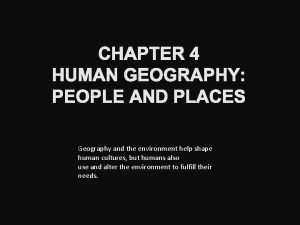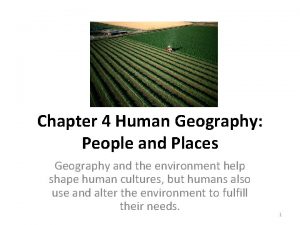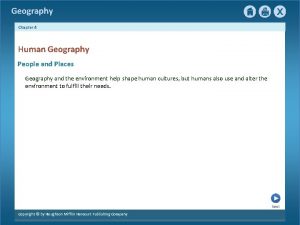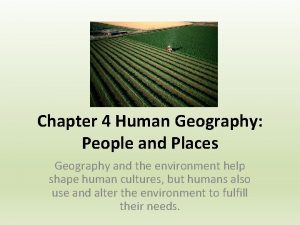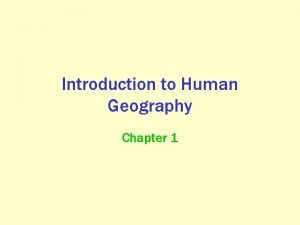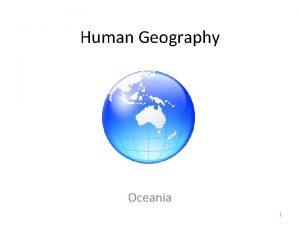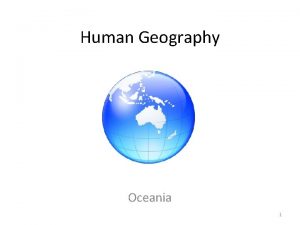HUMAN GEOGRAPHY What is Human Geography People to





















- Slides: 21

HUMAN GEOGRAPHY


What is Human Geography? + = People + to write about the physical structure of Earth’s surface and human activities upon it =human geography

Human Geography is the study of where humans — their activities and institutions such as ethnic groups, cities, and industries— are located and why they are there. Human Geography also examines interactions of humans with their environments and draws on basic elements of physical geography.

Isr co aeli nfl Pa ict les tin Why? Why There? ian ge Bubonic Plague HIV/AIDS Worldwide World Cup BP Gulf Oil Spill no cid e

How to teach APHG? Pedagogy tolerance Globalization ethnocentrism Future Leaders

Goals: On completion of the course, the student should be able to:

• Use and think about maps & spatial data • Understand interpret the implications of associations among phenomena in places • Recognize and interpret at different scales the relationships among patterns and processes • Define regions and evaluate the regionalization process • Characterize and analyze changing interconnections among places

Content Areas of Study: • Geography: Its Nature and Perspectives • Population • Cultural Patterns & Processes • Political Organization of Space • Agricultural & Rural Land Use • Industrialization & Economic Development • Cities & Urban Land Use

1. Geography – 5%-10% • Field of inquiry • Maps and geographers • Geographic concepts: • Location, Space, Place, Scale, Pattern, Regionalization, & globalization • Skills - How to use, interpret, recognize, and/or define: • maps/spatial data • phenomena in places • Relationships at different scales of patterns & processes • Regions & regionalization process Robinson Projection • New technologies • GIS, GPS • Sources of Geographical ideas • Census data

2. Population - 13 -17% • Geographical analysis • Consequences of density, distribution, and scale • Patterns of composition: age, sex, race, & ethnicity • Natural hazards: past, present & future • Growth & decline over time/space • Trends – historical & future projections • Theories & Models • Patterns of fertility, mortality, & health • Regional variations of demographic transitions • Effects of population policies • Population Movement • Push/Pull factors • Voluntary involuntary migration various scales • Migration selectivity • Short-term, local movements, pace Demographic Transitional Model

3. Cultural Patterns & Processes 13 -17% • Concepts of Culture • Traits, Diffusion, Acculturation, Cultural regions • Cultural Differences • Language, Religion, Ethnicity, Gender, Popular & Folk Culture • Environmental impact of cultural attitudes & practices • Cultural landscapes & identity • Values & preferences • Symbolic landscapes & sense of place

4. Political Organization of Space • Territorial dimensions of politics 13 -17% • Territoriality concept • Challenges to inherited political—territorial arrangements • Changing nature of sovereignty • Boundaries • Nature & meaning • Fragmentation, unification, alliance • Influences on identity, interaction, • Spatial relationships between political patterns & patterns of ethnicity, economy, & environment • & exchange • Evolution of contemporary political patterns • Nation-state concept • Colonialism & imperialism • Federal & unitary states • Electoral geography, including gerrymandering

5. Agriculture & Rural Land Use – 13 -17% • Major Ag production regions • Development & Diffusion • Neolithic Ag Revolution • Second Ag Revolution • Rural land use & settlement patterns • Ag systems – bioclimatic zones • Variations within zones & effects of markets • Linkage & flows among regions of food production & consumption • Models – Von Thunen • Settlement patterns & major ag types • Modern Commercial Ag • 3 rd Ag Revolution • Green Revolution • Biotechnology • Spatial Organization & diffusion of industrial ag • Future food supply & environmental impact

6. Industrialization & Economic Development – 13 -17% • Key concepts • Growth & Diffusion of industrialization • Changing roles of energy & technology • Industrial Revolution • Evolution of economic cores and peripheries • Geographic critiques of models of economic localization, (i. e. , land rent, comparative costs of transportation), industrial location, economic • Development, & world systems (i. e. , Wallerstein…) • Contemporary patterns & impacts of industrialization & development • Spatial organization of the world economy • Variations in levels of development • Deindustrialization & economic development • Pollution, health, & quality of life • Industrialization, environmental change, and sustainability • Local development initiatives: government policies

7. Cities & Urban Land Use • Functional character of contemporary cities • Definitions of Urbanism • Origins & evolution of cities • Changing employment mix • Changing demographic & social structures • Historical patterns of urbanization • Rural-urban migration & urban growth • Global cities & megacities • Models of urban systems • Built environment & social space • Comparative models of internal city structure • Transportation & infrastructure • Political organization of urban areas • Urban planning & design • Patterns of race, ethnicity, gender, & class • Uneven development, ghettoization, and gentrification • Impacts of suburbanization & edge cities

Human Geography in Action Unit of Study Field Trip Location Overview Geography Campus Walk Create Map Cultural Patterns & Processes Visit Houses of Worship: Islam (Sunni & Sh’a), Judaism, Buddhism, other religions On a map identify ethnicity & race conflicts worldwide and examine origins of conflicts Political Organization of Space State Board of Elections or General Population, apportionment and drawing district lines Assembly Agriculture & Rural Land Use Local working farm, biotechnology firm or university depart. , food processing plant Collect data and predict future ag production & rural land use; critique models Industrialization & Economic Development Chamber of Commerce or local manufacturing plant Examine the changing geography of jobs; critique models (judgeships, congressional districts) Cities & Urban Land Use City Planning/Zoning Department Exam past, present planning for population city’s vision for land use; making projections using all models; integrate terms (i. e. , gentrification and gehttoization, blockbusting, redlining…)

Debriefing: Field Trip • Examine data • Complete assignment • Presentations • Discussions • Evaluation Field Work

Getting Started • AP Coordinator • One or Two Semesters • Parents • Resources & Support • Permission • AP Night/Nature of Course • E-mail lists • Summer Assignment • Collaboration • Choosing textbooks • Professional Development/Training • AP Exam • Colleges & Universities-Credits & Acceptance • Format • Preparation • Professional Organizations & Identify resources • AP Central • Syllabus • AP Designation • listserve

Resources Type Address Overview Data • www. cia. gov/library/publications/theworld-factbook/geos/gz. html • http: //cia. gov/cia/publications/factbook/index. html Countries A-Z • www. atlaspedia. com/online/country_index. htm Map sites • http: //showmappingworlds. com/ Videos – all units http: //www. learner. org/powerofplace/ *Power of Place Census Bureau • http: //factfinder. census. gov/home/saff/main. html? _lang=en • www. prb. org • http: //demography. anu. edu. au/Virtual. Library/Census. Data. html Population data AP Central • apcentral. collegeboard. com/humangeo Course description, teaching tips, sample syllabi, lesson plans, articles, teacher resources, discussion groups, newsletter, information on exam, sample freeresponse and scoring guides Reading Assignments • The World is Flat, Thomas Friedman • Guns, Germs, & Steele, by Jared Diamond (video) Global Connections • www. pbs. org/wghb/globalconnections • www. nationalgeographic. com/ Textbooks Kuby, Rubenstein, Knox/Marston, De. Blij, etc. Multilingual Newspaper Translator www. humanits-international. org/newstra/index. html Teacher Guides National Council for Geographic Education. The Journal of CIA. The World Factbook Provides broad view of the different units of study in

References de Blij, H. J. , and Alexander B. Murphy. Human Geography: Culture, Society, and Space. 7 th ed. New York: John Wiley, 2003. Knox, Paul L. , and Sallie A. Marston. Places and Regions in Global Context: Human Geography. 3 rd ed. Upper Saddle River, N. J. : W. H. Freeman, 2003. Kuby, Michael, John Harner, and Patricia Gober. Human Geography in Action. 3 rd ed. New York: John Wiley, 2004. National Council for Geographic Education. The Journal of Geography 99, no. 2/3 (May. August 2000). The Power of Place: Geography for the 21 st Century series. N. p. : Annenberg/CPB, 2003. Video. Rubenstein, James M. The Cultural Landscape: An Introduction to Human Geography. 7 th ed. Upper Saddle River, N. J. : Prentice Hall, 2002. www. creativecommons. org www. google. images. com
 Ap human geography frqs
Ap human geography frqs 5 themes of geography ap human geography
5 themes of geography ap human geography Stateless nation
Stateless nation Human development index definition ap human geography
Human development index definition ap human geography Independent blogger people as media
Independent blogger people as media Black eyed peas
Black eyed peas Transformed people transform people
Transformed people transform people People just people
People just people Whats round robin
Whats round robin Ap human geography chapter 11 vocab
Ap human geography chapter 11 vocab Geography lines
Geography lines Alpha beta gamma cities ap human geography
Alpha beta gamma cities ap human geography Substitution principle example ap human geography
Substitution principle example ap human geography Bulk gaining industry ap human geography
Bulk gaining industry ap human geography Von thunen theory of agricultural location
Von thunen theory of agricultural location Thnen
Thnen Von thunen model graph
Von thunen model graph Township and range aphg
Township and range aphg Suburban sprawl definition ap human geography
Suburban sprawl definition ap human geography Clustered definition ap human geography
Clustered definition ap human geography Central place theory definition geography
Central place theory definition geography Brandt line
Brandt line









